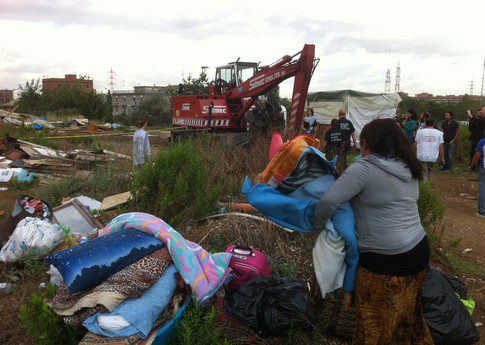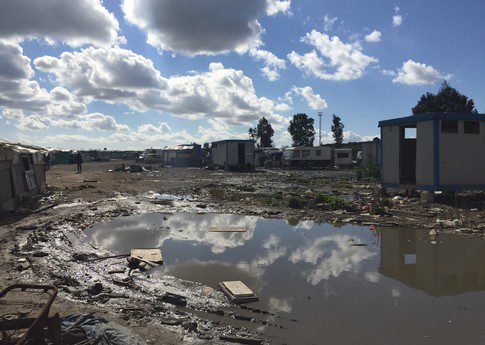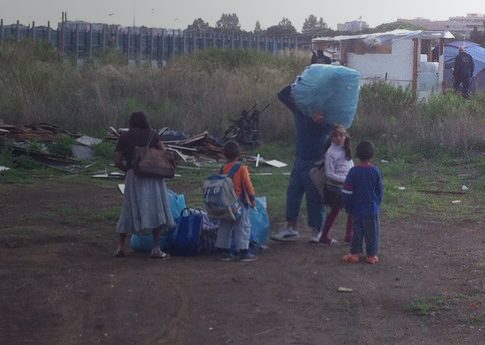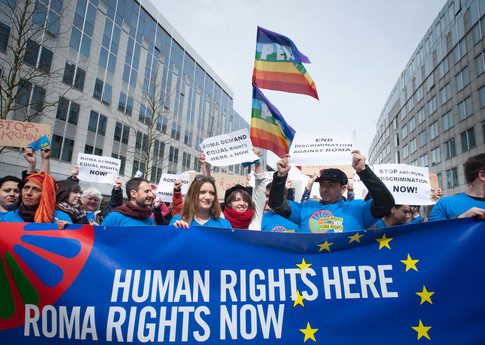In early 2012, the adoption by the Italian government of the National Strategy for Roma Inclusion (the National Strategy), had the potential to mark a turning point for many Romani families who, for years, had experienced forced evictions, segregation and discrimination in access to housing in Italy.
Promising to “overcome large-sized mono-ethnic settlements” and “increase access to a wide range of housing solutions”, the National Strategy brought hope to families and organizations which for years had been denouncing the widespread and systematic human rights violations experienced by Romani women, children and men.
However, as we celebrate International Roma Day on 8 April, it is painfully clear that, four years on, the promises engraved in the ink of the 2012 document have just simply become mirrors and smoke. Life for thousands of Roma in Italy remains as difficult as ever, as they continue to be faced with official neglect and prejudice.
Life for thousands of Roma in Italy remains as difficult as ever, as they continue to be faced with official neglect and prejudice.
Amnesty International

Injustice as a daily reality
Segregation, forced evictions and discrimination in access to housing remain the daily reality of Romani communities in Italy. Some families continue to be placed in mono-ethnic camps across the country, often in appalling living conditions, near airport runways or on the outskirts of the cities, far away from services, schools and jobs.
Others live in fear that at any time, authorities might come and tear them away from the place they call “home”, placing them in mono-ethnic shelters, or worse, leaving them on the streets.
Romani families that seek to access social housing and benefits often see their attempt bluntly crushed by criteria they cannot comply with.
These abuses affect Italian citizens, stateless people and individuals of different nationalities, all having one thing in common: being Roma.
In numbers


The vicious and discriminatory circle of segregated camps
In 2013, in the town of Giugliano, on the outskirts of Naples, almost 400 Romani children, women and men were placed by the local authorities in the “Masseria del Pozzo” camp, next to a landfill stocking toxic waste. When they arrived in the new “home”, people recall that they could only see a fence and few basic and limited services. No homes, no wider community, but a piece of land in the middle of nowhere.
In 2013, when they moved us here, there was an unbearable smell… Today there is white fumes coming out of the ground …
An inhabitant of Giugliano
Abandoned by the authorities, and without adequate maintenance, the camp soon became uninhabitable, with broken toilets, rampant garbage, and general desperation among the inhabitants.
Recently, a court ordered the seizure of the land and the removal by the municipality of the families away from the perilous conditions. What better opportunity for the authorities to do the right thing and comply with the promises made in the National Strategy, to give people dignified housing?
But no! Instead, the local, regional and national authorities negotiated a solution – without involving the community at any stage – and approved the construction of yet another camp! No social housing, no assisted rental, no creative schemes to facilitate access to housing for the Roma in Giugliano. For them, yet another segregated camp.
We want houses, no more camps…Why use the money and build camps, and why not instead use it to give our children a good life?
Boris

From a longstanding home to a temporary centre, how is this leading to integration?
On 15 March 2016, around 100 women, children and men were forcibly evicted from their longstanding authorized settlement in via Idro, Milan, the biggest city in northern Italy.
As a result of the eviction, families were forced out of the homes where they had been living – some for over 25 years.
Families were not necessarily opposing the relocation away from the camp, and in fact some had sought help to get out of it. However, authorities ordered the closure of the camp but did not provide residents with adequate alternatives able to facilitate their long-term integration. Instead, they transferred them to temporary accommodation centres, shelters for the homeless, and another Roma camp.
The closure of mono-ethnic camps is a legitimate policy objective, and a positive one if it leads to desegregation. But how can an integration route be initiated by being forcibly evicted from one’s longstanding home and being sent to a shelter for the homeless?

Access to Social Housing – A Dream
Integration and inclusion are what thousands of Romani families desperately seek and almost never achieve in Italy. For many, access to social housing remains a dream. The system they need to navigate is a nightmare. Not only is there a severe shortage of available social housing for thousands of families from all backgrounds, the authorities have also introduced or enforced criteria, in some cases, that side-line Roma and hamper their chances of accessing social housing and benefits.
Miriana is an Italian citizen of Romani ethnicity who lives in the authorized camp of via Salone, in Rome, with her husband and four children, including twins born in mid-2013.
“The situation has worsened, with no maintenance the camp was left to ruin. Now there are also policemen outside the camp checking our documents all the time. I also went to the municipality to apply for the benefits awarded to those on ‘housing emergency’, but they told me it was not possible as I am given accommodation in a camp. Other residents couldn’t bear it any longer and moved to other countries. But I am an Italian citizen, where am I supposed to go?””
In cities like Rome, people evicted from informal camps are often left homeless, with no other option than to build for themselves a new shack in a different area of the city, even more hidden and, often, more dangerous. In other cases, the municipality offers them temporary housing in mono-ethnic shelters. There, they have no right to housing benefits which are available to facilitate people’s access to subsidized rent. So, for the many without a sufficient and stable income, it is impossible to get out of the shelter and find alternative housing.

How could the vicious cycle be broken once and for all?
The reality of segregation, forced evictions and discrimination in access to housing is not new in Italy. Despite its 2012 National Strategy commitment to secure “dignified housing” for Roma, the Italian government has so far failed to deliver on its promises. There is no sign of a plan to offer a range of adequate housing options devised with the families themselves. On the contrary, the authorities are now building new segregated camps. They have failed to inject fresh resources for social housing or review public offers to ensure Roma are not discriminated against. They have not even tried to adopt legislation or guidelines to ensure evictions are carried out according to international standards.
Meanwhile, children keep growing up in segregated camps, see their few belongings taken away by bulldozers, watch their parents losing faith in the system that should uphold their rights. While this may not be new, it is still shocking.
International Roma Day is not simply a day to celebrate Roma people, their history, culture and contribution to the societies they live in. It is also a day to highlight Italy’s and Europe’s failure to treat Roma equally and with dignity, and a reminder of the struggle that is still required to achieve full equality for Roma!

